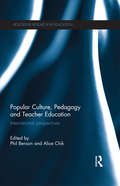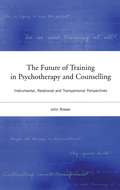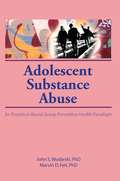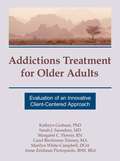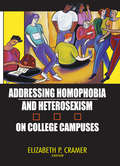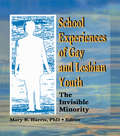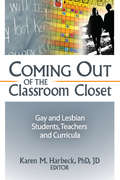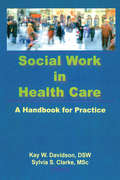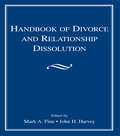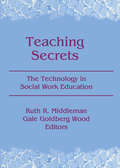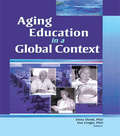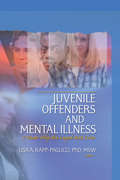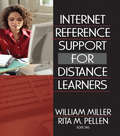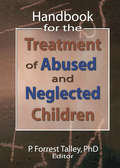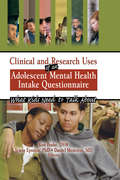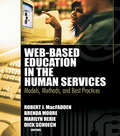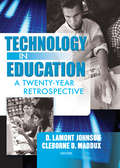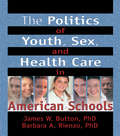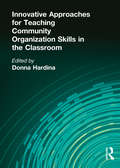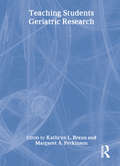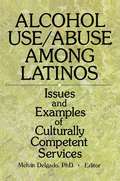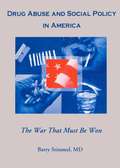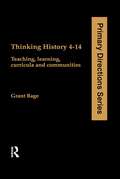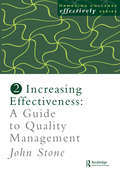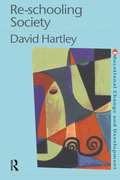- Table View
- List View
Popular Culture, Pedagogy and Teacher Education: International perspectives (Routledge Research in Education)
by Phil Benson Alice ChikThe integration of popular culture into education is a pervasive theme at all educational levels and in all subject areas. Popular Culture, Pedagogy and Teacher Education explores how ‘popular culture’ and ‘education’ come together and interact in research and practice from an interdisciplinary perspective. The international case studies in this edited volume address issues related to: how popular culture ‘teaches’ our students and what they learn from it outside the classroom how popular culture connects education to students’ lives how teachers ‘use’ popular culture in educational settings how far teachers should shape what students learn from engagement with popular culture in school how teacher educators can help teachers integrate popular culture into their teaching Providing vivid accounts of students, teachers and teacher educators, and drawing out the pedagogical implications of their work, this book will appeal to teachers and teacher educators who are searching for practical answers to the questions that the integration of popular culture into education poses for their work.
The Future of Training in Psychotherapy and Counselling: Instrumental, Relational and Transpersonal Perspectives
by John RowanThe Future of Training in Psychotherapy and Counselling presents a revealing and stimulating account of the current state of training that demonstrates how training will have to adapt if it is to sucessfully meet the needs and challenges of the future.In an attempt to look afresh at the whole question of training, John Rowan proposes that there are three ways of doing therapy and any examination of training has to consider each of these:* the instrumental, where the main emphasis is on the treating the client or patient * the authentic way, where the main emphasis is on meeting the client or patient* the transpersonal way, where main emphasis is on linking with the client in a more personal way. Each approach makes different assumptions about the self, about the relationship, and about the level of consciousness involved in doing therapy. By challenging the basic precepts of traditional training, John Rowan encourages the reader to reconsider subjects including the difference between counselling and psychotherapy, culture and ethics, the origins of disturbance in clients, and child development. The Future of Training in Psychotherapy and Counselling provides a much needed new perspective that will compel all psychotherapists and counsellors to take a closer look at training in the field.
Adolescent Substance Abuse: An Empirical-Based Group Preventive Health Paradigm
by John S Wodarski Marvin D FeitHere is a comprehensive review of adolescent substance abuse issues and an expansive, empirically based curriculum for school-based programs to teach adolescents about the dangers of drugs and alcohol. The abuse of alcohol and other drugs among young people is a problem of alarming scope and gravity. Adolescent Substance Abuse explores the multiple forces which impact adolescents and can push them toward drug and alcohol abuse.Adolescent Substance Abuse proposes means by which to effect macro-level change in societal norms and values regarding substance abuse. The authors describes in detail an effective means of teaching adolescents about drugs and alcohol using an empirically based teaching method called Teams-Games-Tournaments (TGT). TGT was developed through extensive research on games used as teaching devices. It uses small groups as classroom work units and capitalizes on peer influence by using peers as teachers and supporters. The book explains an effective curriculum which utilizes the TGT approach and provides a program for parents. The curriculum is unique in that it is anchored in empirical data and delivered via adolescent peer groups. Adolescent Substance Abuse addresses other issues pertinent to the reduction of adolescent substance abuse by exploring subsystems of change, including school and peer group environments, home and family, the media, community movements, and business and industry. The book is a great source of innovative ideas for beginning and expert counselors, social workers, mental health professionals, school psychologists, and others who want to prevent adolescent abuse of drugs and alcohol.
Addictions Treatment for Older Adults: Evaluation of an Innovative Client-Centered Approach
by Kathryn Graham Sarah J Saunders Margaret C Flower Carol B Timney Marilyn White-Campbell Anne ZeidmanHere is a detailed description of an innovative approach for treating elderly persons who have alcohol or drug problems. During the past few years there has been growing recognition of the special needs of these individuals. Addictions Treatment for Older Adults describes the evaluation of the Community Older Persons Alcohol (COPA) Program. This book helps readers understand the nature of substance abuse among the elderly, as well as how to identify and intervene with older persons who have alcohol and drug problems, including persons who are reluctant to seek treatment. Addictions Treatment for Older Adults explains the development of the COPA program and how it works. Many case studies and tables provide illuminating details for readers who work with this elderly population. Chapters examine characteristics of elderly persons with alcohol or drug problems the typology of COPA clients and their problem areas treatment interventions variables associated with improvement analysis of progress made by clients during and after treatment the factors that seem to predict recoveryThe in-depth descriptions in this book provide much needed information and guidance for professionals striving to meet the treatment and care needs of elderly substance abusers. Addictions Treatment for Older Adults should be read by researchers in the substance abuse field and by persons who work with the elderly, such as community nurses, social workers, and physicians. In this book they will find the best description to date of the nature of alcohol and drug problems among elderly who live in their communities.
Addressing Homophobia and Heterosexism on College Campuses
by Elizabeth CramerThis book presents an integrated approach toward changing attitudes about lesbian, gay, bisexual, and transgendered (LGBT) students, faculty, and staff on contemporary college campuses. From Addressing Homophobia and Heterosexism on College Campuses you can learn specific classroom techniques for handling homophobia and heterosexism in the classroom. This book tackles a wide variety of subjects including academic freedom, diversity training, nontraditional families, and religion, each of which plays an integral part in the sense of community found on any college campus. Addressing Homophobia and Heterosexism on College Campuses provides you with the basic tools to set up sensible programs that have worked for others in the past and can work for you in the future! In Addressing Homophobia and Heterosexism on College Campuses you'll also find: a list of helpful feature films and documentaries case studies from the US, Canada, and Australia methods to combat homophobia and heterosexism among social work students practical ways to set up Safe Zone or Allies programs techniques for reducing "trans-anxieties" lectures and role-playing games geared toward changing thoughts and live
School Experiences of Gay and Lesbian Youth: The Invisible Minority
by Mary B HarrisSchool Experiences of Gay and Lesbian Youth: The Invisible Minority shows teachers, youth advocates, administrators, and academic researchers how to embrace the needs of sexual minority students. Through research and case studies, this book explains the ways in which schools are failing the vulnerable population of gay, lesbian, and bisexual youths. This text shows you how to take responsibility for recognizing and protecting the rights and needs of gays and lesbians and ridding schools of discrimination, harassment, and violence.As School Experiences of Gay and Lesbian Youth illustrates, the consequences of the cognitive, social, and emotional isolation that sexual minority youths experience as a result of homophobia and heterosexism can be devastating. With this book’s helpful suggestions, provocative insight, and open challenges, you can help gay and lesbian youths develop feelings of self-worth as well as positive aspirations for their futures. Experiences of Gay and Lesbian Youth will help social workers, psychologists, academics, counselors, and other professionals understand: the dearth of role models in the career development of lesbian and gay youths how to integrate sexual orientation into career counseling how to incorporate the topic of homosexuality into educational curricula forms of homophobia (from the victim’s and the agressor’s points of view) and heterosexism in the high school environment how to open discussions about gay and lesbian issues at school the importance of having visible lesbian, gay, and bisexual staff who can provide support for sexual minority youthSchool Experiences of Gay and Lesbian Youth also informs you on the experiences gay and lesbian adults who attended high school five to fifty years ago, as well as college students who have reported incidents of homophobic behavior in high school. In addition, this text discusses teachers’fears of being fired as a result of talking about sexual minority issues and how school environments can lead students to become drop outs. Experiences of Gay and Lesbian Youth will inform you on the issues facing gay and lesbian youth and provide you with suggestions on how to make the classroom a welcoming environment, regardless of sexual orientation.
Coming Out of the Classroom Closet: Gay and Lesbian Students, Teachers, and Curricula
by Karen M HarbeckThis landmark book empowers educators to become visible, positive influences and role models for gay and lesbian students in their classrooms and schools. As most homosexual educators, and even students, remain invisible due to possible hostilities of “coming out,” this eye-opening book presents recent research to help gay and lesbian teachers break their silence. It encourages them to speak out on issues of homosexuality where curricula, civil rights, personal freedoms, and social entitlements are concerned. It promotes the development of school-based intervention for gay, lesbian, and bisexual students.While the controversy over education and homosexuality is one of the most personally threatening in this nation’s history, the timely research presented in Coming Out of the Classroom Closet will hearten gay and lesbian educators to continue to strive for fair treatment as peers and for equal representation in educational materials. Pointing to reports of greater social support and legal protection than is assumed by most in the educational system, this book should be required reading for all persons concerned about continuing to provide high-quality education at all levels--college and university, secondary, and even elementary.Chapters of Coming Out of the Classroom Closet look closely at many issues surrounding the issue of homosexuality in schools, including a history of treatment of gay and lesbian educators and their legal rights; effects of internalized homophobia on homosexual educators; gay and lesbian student’s perceptions of their counselors and teachers ability to understand and help; beliefs, lack of knowledge, and lack of training of counselors and teachers about the needs of gay and lesbian youth; images of gays and lesbians in sexuality and health textbooks; important AIDS education; and the issue of homophobia.
Social Work in Health Care: A Handbook for Practice (Social Work In Health Care Ser. #Vol. 12, No. 3)
by Kay DavidsonHere is an outstanding reference book of major readings in the field of social work in health care. Practitioners, educators, researchers, and students can use this landmark two-part volume to review dominant themes and critical issues in today’s practice environment and to understand the evolution of current trends and emerging policies and programs. In this one desktop source book, hundreds of references relevant to the health care social work field are immediately accessible. Education, policy, practice, and research issues integral to social work’s expanding role in health care are the main focus, with each chapter highlighting a theme of enduring importance to the field. Other outstanding articles related to the chapter’s theme are cited in the appendix to each chapter which also includes a selected bibliography of suggested topical readings. Comprehensive new book filled with information vital to social workers in the health care field! Over 900 pages of scholarly articles by the foremost social work leaders in health care! 9 categories embrace the range of social work activity in the health care field! Exciting new ideas and practical suggestions for everyday dilemmas! Hundreds of references immediately accessible in one desktop source! Selected bibliography of topical headings provides sources for even more relevant articles! A MUST HAVE volume for instructors and students! Deepen your understanding of all aspects of social work practice in health care with this superb volume! Here is an outstanding reference book of major readings in the field of social work in health care. Practitioners, educators, researchers, and students can use this landmark two-part volume to review dominant themes and critical issues in today’s practice environment and to understand the evolution of current trends and emerging policies and programs. Social Work in Health Care makes hundreds of references relevant to the health care social work field immediately accessible in this one desktop source book. Education, policy, practice, and research issues integral to social work’s expanding role in health care are the main focus, with each chapter highlighting a theme of enduring importance to the field. Other outstanding articles related to the chapter’s theme are cited in the appendix to each chapter which also includes a selected bibliography of suggested topical readings. Find answers and ideas for everyday dilemmas in this all-inclusive, information-packed volume!Social workers practicing in the rapidly expanding health care field call upon a repertoire of skills to fulfill a variety of functions including direct patient care and contact with patients’families, education, and influencing organizational policies on their clients’behalf. The in-depth scholarship and the diversity of multiple approaches to health care social work, as presented in Social Work in Health Care, will have a strong impact on the field. Through the intertwining network of education, policy, practice, and research issues in the book, and professsional discussion of those topics, a beginning point exists from which social workers can develop principles to guide their social work activities in the medical and health fields.
Handbook of Divorce and Relationship Dissolution
by Mark A. Fine John H. HarveyThis Handbook presents up-to-date scholarship on the causes and predictors, processes, and consequences of divorce and relationship dissolution. Featuring contributions from multiple disciplines, this Handbook reviews relationship termination, including variations depending on legal status, race/ethnicity, and sexual orientation. The Handbook focuses on the often-neglected processes involved as the relationship unfolds, such as infidelity, hurt, and remarriage. It also covers the legal and policy aspects, the demographics, and the historical aspects of divorce. Intended for researchers, practitioners, counselors, clinicians, and advanced students in psychology, sociology, family studies, communication, and nursing, the book serves as a text in courses on divorce, marriage and the family, and close relationships.
Teaching Secrets: The Technology in Social Work Education
by Ruth Middleman Gale Goldberg WoodTeachers and student teachers in social work will gain valuable insight into the artistry that makes truly great teaching from the accounts found in this new book. Master teachers examine the processes they use in the classroom and present them in a format that facilitates the practical application of their ideas. The teaching methods recounted here emphasize the learners as the most important component of the teaching/learning experience and demonstrate techniques to enliven and enhance the reader’s own teaching methods. This vital book focuses on teaching “technologies,” defined as bodies of knowledge or skills ordered for use, that are comprised of techniques or systematic procedures that bring the technologies to life. By utilizing the techniques and technologies portrayed in this volume, social work educators at the graduate and undergraduate levels will become more effective at reaching their students and helping them grow into professional social workers.Teaching Secrets helps teachers increase the effectiveness of their teaching by demonstrating how to pay attention to acts and nuances that stimulate and assist students in their learning. Individual chapters focus on specific classroom environments, providing practical advice to improve learning in each situation. Social work teachers will discover more effective teaching through the use of student journals, the use of self in teaching doctoral research, the use of authority, and the benefits of student-student learning in work groups. Other chapters offer practical advice on reaching different groups of students such as black teachers leading white students, white teachers leading black students, and special efforts for reaching female students. This exciting book reveals that great teachers are not born but made, and shares the secrets that will help all social work educators to develop greatness in their own classrooms.
Aging Education in a Global Context
by Dena Shenk Lisa GrogerA selection of proceedings from the 2004 Association for Gerontology in Higher Education annual conference Aging Education in a Global Context is a carefully considered set of papers based on selected proceedings from the 2004 Association for Gerontology in Higher Education annual conference. Each forward-thinking presentation provides unique perspectives on teaching resources and education, presenting a wellspring of creative ideas for new and experienced teachers in gerontology and aging education. Respected educators present cutting-edge concepts and effective strategies in gerontology curriculum development and cross-cultural perspectives for advancing gerontology as a field of study. Over the next twenty years, the world's aging population will increase dramatically, requiring increased attention to global aging issues. To prepare gerontologists around the world for future challenges, Aging Education in a Global Context provides educators with fresh viewpoints and practical information on which to base the latest teaching strategies. Each presentation provides a multitude of valuable ideas perfect for incorporating into aging education curriculums, such as how to use films and literature for teaching about aging, how to enfold global perspectives into aging courses, and how to avoid cross-cultural misunderstandings when teaching gerontology in a host country. This invaluable resource is extensively referenced.Aging Education in a Global Context examines aging education, issues, and ageism topics such as: the consequences of globalization for older people a course design incorporating cross-cultural, anthropological approaches to understanding aging an approach to teach about death and dying through the cross-cultural viewpoint of various religious faiths a study of fourteen international films that provides gerontologists with models of successful aging to pass on in coursework teaching cross-cultural aging using Chilean literary portrayals of elders the evolution and present state of gerontology education in Japan gerontology research and cooperative education in Kenya educating about community-based long-term care in ChinaAging Education in a Global Context presents a wealth of new ideas for all gerontology educators and educators addressing cross-cultural aging issues within discipline-based courses in sociology, social work, anthropology, public policy, and psychology.
Juvenile Offenders and Mental Illness: I Know Why the Caged Bird Cries
by Lisa A. Rapp-PaglicciGet the latest research on juvenile offenders who have a mental illnessMost youths in the juvenile justice system who have one or more mental disorders do not receive proper treatment or education, nor do they serve sentences appropriate for their crimes. Juvenile Offenders and Mental Illness: I Know Why the Caged Bird Cries takes a detailed look at the latest theories and empirically based information on the causal and recidivism problems youths with mental disorders face in the juvenile justice system. Respected experts comprehensively discuss the range of problems found in the assessment of mentally ill juvenile offenders and offer practical, effective treatment solutions.Juvenile Offenders and Mental Illness explains the cost-effective methodologies and presents the latest data on recidivism rates and occurrences of depression, Attention Deficit Hyperactivity Disorder (ADHD), and/or alcohol or substance abuse disorder among delinquent adolescents. Research studies also include data gleaned from the application of the Piers-Harris Children&’s Self-Concept Scale, the Beck Hopelessness Scale, and other scales and surveys on participants. Other topics include revealing data on the prevalence of lifetime use of Ecstasy (MDMA) and its effects; female shoplifting and its relationship to mental illness; incidence of trauma exposure in incarcerated youth; and strategies to enhance the effectiveness of interventions. The book includes helpful tables to clearly illustrate empirical data and provides detailed references for each chapter.Juvenile Offenders and Mental Illness provides the freshest research and insightful discussion on: adolescent stalking depression ADHD alcohol/substance abuse disorders Post Traumatic Stress Disorder (PTSD) Ecstasy (MDMA) use and its association with symptoms of anxiety or depression the impact of mental health treatment intensity on the emotional and behavioral problems of youth in a treatment facility shoplifting by female teens behavioral problems and suicide-tendency in youths who have been sexually abused or traumatized effective prevention and the reduction of violence by at-risk adolescentsJuvenile Offenders and Mental Illness: I Know Why the Caged Bird Cries provides vital research data and treatment options for social workers, forensic psychologists, and those working in the juvenile justice system.
Internet Reference Support for Distance Learners
by William Miller Rita PellenMake separate library services for distance learners a thing of the past Internet Reference Support for Distance Learners takes a comprehensive look at efforts by librarians and information specialists to provide distance learners with effective services that match those already available on campus. With the development of the World Wide Web and the evolution of Web-based services, reference librarians are adding a human element to the virtual library, blurring the difference between distance learners and traditional users. This unique book examines how they deal with a wide range of related topics, including standards and guidelines, copyright issues, streaming media, and chat and digital references, and presents a historical overview of how reference and instructional services have been delivered to distance users-before and after the creation of the Internet.Internet Reference Support for Distance Learners reveals that librarians do not make a sharp distinction between reference and instruction within the context of distance learning, and that there is no clear boundary between "true" distance learners and more traditional students who might use services designed for nontraditional users. Online capabilities have allowed reference librarians to approximate services advocated by published guidelines and standards, including the ACRL Distance Learning Section&’s Guidelines for Distance Learning Library Services, to provide a framework for librarians to plan services for off-campus students.Internet Reference Support for Distance Learners provides practical information on: how librarians can "keep IT simple" when designing methods to access reference support why library Web sites are vital sources of communication between the distance learning student and the reference-based instructional component how to set up a university chat service, including software selection, staff training and assessment how to provide students services beyond traditional provision of resources, including advising, enrollment, and payment of fees how to create an online assistance site that incorporates online versions of traditional print handouts, FAQs, subject guides, course-specific guides, learning modules, and instructional videos in one central location how to work with faculty to create online support for students in Blackboard courses the pros and cons of using open-source software how to create an online library assistance site how to create online information literacy course to teach independent research skills to remote students how to avoid copyright infringement and how to educate library personnel about copyright law how to use Camtasia Studio, a screen capture program to create audio and video for online presentationsInternet Reference Support for Distance Learners is an invaluable resource for librarians working in academic, school, special, and public settings, and for library science faculty and students.
Handbook for the Treatment of Abused and Neglected Children (Haworth Social Work Practice With Children And Families Ser.)
by P. Forrest TalleyPractical solutions for difficult clinical situations!With many chapters written by some of the field's best known contributors, this handbook was developed for the practitioner who wants practical and effective guidance for helping abused children. Each major area of clinical practice is discussed by experienced professionals, providing you with new insights and ideas regarding: medical findings; clinical assessment; individual, group, and family therapy; testifying in court; the role of medication in treatment, and much more. To make the application from the written page to your practice even more compelling, every clinical chapter is followed by a patient vignette that demonstrates how the principles just described can be successfully applied in the working world of therapists. Whether abused children number only a few or many on your caseload, this is a handbook to which you will often refer over the years. The Handbook for the Treatment of Abused and Neglected Children pulls together a wide range of practical information for therapists on how to effectively work with abused and neglected children. Unlike other volumes on the subject, this book puts the information in context, with a &’big picture&’ overview of how the therapist fits into the larger system into which the child has been swept up-Child Protective Services, legal proceedings, medical issues, disputes regarding custody, etc. Inside, you&’ll find effective strategies for: conducting individual therapy with abused children-how to begin therapy, identify distortions, effectively challenge ingrained patterns of behavior, and constructively bring therapy to a close navigating the maze of Child Protective Services-knowing what resources are available, what obstacles are likely to arise, and how to work with social workers understanding the medical findings of maltreated children-how information from a child&’s physician can provide critical insights into the child&’s experience, and often into children&’s expectations of future relationships testifying in court as a therapist-how the court works and how to prepare to give effective testimony facilitating parent interventions-how to help mothers and fathers develop relationships with their children to the fullest and nurture each child&’s potential as his or her personality developsThe Handbook for the Treatment of Abused and Neglected Children will prove valuable for students and educators as well as novice and experienced therapists. Whether you see children only occasionally or focus your practice on maltreated children, this one-of-a-kind resource deserves a place in your professional collection.
Clinical and Research Uses of an Adolescent Mental Health Intake Questionnaire: What Kids Need to Talk About
by Irwin Epstein Ken Peake Daniel MedeirosLearn how to better clinically serve "risky" adolescents-from the clients themselves!Clinical and Research Uses of an Adolescent Mental Health Intake Questionnaire: What Kids Need to Talk About explores the research on adolescent behavior culled from the answers to a clinician-designed intake questionnaire given to adolescent clients asking how they view their own risks, what they worry about, and what they wish to talk about. Respected authorities discuss the enlightening findings and present ways to reshape services, taking into account customer preference, risk and worry, and youth development (YD) perspectives while presenting practical clinical strategies to engage at-risk adolescents in mental health treatment.Clinical and Research Uses of an Adolescent Mental Health Intake Questionnaire: What Kids Need to Talk About provides conceptual models that practitioners and organizations can use to develop reflective practices and to understand better how to engage adolescent clients in treatment. The book includes three case studies that illustrate an organization&’s experience in developing ways for organizational learning, including the clinicians&’ own accounts of their experience in conducting practice-based research. Two chapters describe the development and the clinical uses of the intake questionnaire and offer guidelines for other practitioners to develop their own. The book discusses specific findings about adolescent risk, worries, and desire to talk across a wide range of psychosocial domains such as education and work, sex and sexuality, safety, substance abuse, and family and friends. Other research examines adolescent risk and vulnerability profiles of lesbians, gays, and bisexuals, as well as the impact of racism. Finally, the book builds upon this empirical analysis to address the clinical challenge of engaging "risky" adolescents in counseling.Clinical and Research Uses of an Adolescent Mental Health Intake Questionnaire: What Kids Need to Talk About analyzes: adolescent risks, worries, and coping adolescent help seeking and desire to talk in counseling youth development (YD) and adolescent vulnerability urban adolescents&’ health and mental health concerns effectively engaging adolescents in counseling collaborative strategies for clinicians and managers reflectivity and learning in human service organizationsClinical and Research Uses of an Adolescent Mental Health Intake Questionnaire: What Kids Need to Talk About presents essential information for social workers, mental health professionals who work with adolescents, adolescent researchers, pediatricians and adolescent medicine practitioners, teachers, students, and youth workers.
Web-Based Education in the Human Services: Models, Methods, and Best Practices
by Richard Schoech Brenda Moore Robert James Macfadden Marilyn HerieA much-needed look at innovative and effective methods for creating virtual learning environments for human servicesWeb-Based Education in the Human Services reflects the vitality and diversity of Web-based courses currently delivered within human services. Unlike previous texts that have combined technologies such as Interactive Television (ITV) and two-way audio where Web involvement was minimal, this unique book focuses on Web-based models, tools, and techniques used in courses where the majority of the content is delivered online. The book&’s contributors emphasize the social aspects of learning, examining topical areas not usually associated with Web-based education as they remind us of the need to move beyond the similarities between WBE and face-to-face (FTF) approaches.Web-Based Education in the Human Services documents a course delivery method coming of age in its desire to create virtual learning environments that incorporate a variety of techniques and strategies. These environments use concepts and tools beyond what packages such as WebCT currently offer, highlighting the power of designing a complete Web-based curriculum, rather than viewing each course separately. Many of the most successful approaches presented in this invaluable book don&’t involve sophisticated tools or programming, but the creative design of interactive scenarios, emotional content, and feedback mechanisms that reinforce the instructor&’s role as the crucial ingredient for success. Web-Based Education in the Human Services examines: adult learning theories teaching practice skills through Web-based technology how to bridge the gap between theory and practice faculty perceptions of the effectiveness of Web-based instruction compared to face-to-face instruction the accessibility of Web-based education the significance of emotion in learning Web-based delivery of a graduate professional training program the creation, delivery, and evaluation of a pilot course using Blackboard 6 the development of a Web-based undergraduate child welfare course the use of Web-based video clips for counselor skills training the design, development, pilot, and revision of a Web-based social work practice course an online format for agency-based field instruction the design of a Web-based graduate program in counseling psychology and much more!Web-Based Education in the Human Services is an invaluable resource for social work and human services educators, including education, nursing, and psychology, Web-course developers, and college and university administrators.
Technology in Education: A Twenty-Year Retrospective
by Cleborne D Maddux D Lamont JohnsonExamine the history of the microcomputer and its impact on education! Under the editorship of D. LaMont Johnson, PhD, a nationally recognized leader in the field of educational computing, Computers in the Schools has been a powerful tool in educational settings. Now, after 20 years, Professor Johnson muses on how far information technology has come. Technology in Education: A Twenty-Year Perspective brings you a retrospective look at the trends and issues relating to the integration of computers into the school curriculum covering 25 years. He joins several other colleagues to follow the historical journey of the "dream machine" to the technological wonder it has become. Technology in Education: A Twenty-Year Perspective will leave you better informed on such topics as: the obstacles slowing the integration of information technology in education-why are computers still collecting dust in many classrooms? the predictions that were made by early computer enthusiasts, and how close or off the mark those predictions came how information technology has impacted education and society so far historical advances in education that should be celebrated, such as the advent of the World Wide Web the student&’s perspective of computers in education and much more! Computers in the Schools is the one of the oldest academic journals dealing directly with the integration of information technology into the educational setting. Technology in Education: A Twenty-Year Perspective provides an important overview by some of the leading experts in the field. From the earliest predictions and opinions to the latest trends and findings, this book, celebrating the journal&’s twentieth anniversary, is a vital research tool for students and professors of information technology in education.
The Politics of Youth, Sex, and Health Care in American Schools
by Marvin D Feit Barbara A RienzoExamine school-based health clinics and the political considerations and strategies that can help them succeed!The Politics of Youth, Sex, and Health Care in American Schools reveals the history and political dynamics involved in building and sustaining an important innovation in the way health care services are delivered to America’s youth: the school-based health clinic. These clinics provide vital health services--including crucial yet controversial reproductive services--to youth. In addition to analyzing the nature and extent of the political barriers facing school-based clinics, this vital book describes the strategies that have proven most effective in overcoming them.This essential book begins with an overview of the existing literature on the history and provision of health care for youth. Then it presents the results of a study that utilized a two-pronged approach: a nationwide survey of clinic administrators (supplemented with aggregate data) and intensive case studies of five representative locales. By combining the quantitative data from the national survey with the more qualitative information gleaned from the case study field work, The Politics of Youth, Sex, and Health Care in American Schools can deliver broad yet accurate generalizations as well as detailed interpretation of the authors’findings.This informative and insightful volume explores: the ways that school-based health clinics (SBHCs) have evolved, confronted opposition, and grown day-to-day issues that SBHCs face, including inadequate funding, lack of parental involvement, unsupportive teachers and schools, staffing/training issues, cultural issues, and more sources of opposition to SBHCs, including fundamentalist Protestants, Black Evangelicals, Catholics, and conservative parent groups ways to establish successful school health care reforms issues and recommendations for SBHCs in the futureTo date, there have been very few empirical studies of the politics of school health or of the provision of sexuality-related health services for youth. The greatest depth and breadth of information you can find on the subject is here, in The Politics of Youth, Sex, and Health Care in American Schools.
Innovative Approaches for Teaching Community Organization Skills in the Classroom
by Donna HardinaBring your students the latest developments in community organization!Innovative Approaches for Teaching Community Organization Skills in the Classroom will help social work educators efficiently teach students methods of practice that they need to know in order to offer the best services to clients with a variety of different needs in a variety of settings. Here you'll find assignments and exercises that combine new technology with progressive ideas about integrating theory and practice. This valuable book consistently addresses topics that will stimulate discussion on the value assumptions inherent in community practice, appropriate ways to transmit these values in the classroom, and the best way to help students develop their own frameworks for ethical decisionmaking.Innovative Approaches for Teaching Community Organization Skills in the Classroom will be a valuable addition to your collection. This accessible and comprehensive book identifies and provides detailed information for teaching these skills in the classroom: ethical decisionmaking community assessment interpersonal skills development making your practice effective in a multi-cultural environment organizing your practice with computer technologyThis book describes teaching methods that will educate your students on the development of self-awareness, multicultural competency, and ethical content for practice, preparing them for the diverse situations that may arise in their professional careers.
Teaching Students Geriatric Research
by Margaret A Perkinson Kathryn BraunTeach your students essential skills in conducting research, building collaborative partnerships, and working with clients and caregivers!This important book provides health care educators with information, examples, and suggestions to help teach students appropriate research techniques amidst a growing demand for evidence-based practices. Offering two effective and efficient methods, the apprenticeship model and the partnership model, Teaching Students Geriatric Research will show you how to incorporate these research fundamentals in an already heavy courseload. By providing conceptual rationales and guidelines for these models and directions on how to use them, this thorough guide will assist you in enhancing research training for your students and preparing them for a career in the health professional field. Through this unique book, you will find clear descriptions and illustrations of the apprenticeship and partnership models of research to help you provide your students with a hands-on leaning experience. Teaching Students Geriatric Research provides you with guidelines and suggestions on how to successfully use both models of training described in this book, such as: exploring guidelines for training students and incorporating them into ongoing research discussing students’reflections on the relevance of research training for professional development based on their own experiences as research apprentices discovering the various skills that students can develop as a result of their involvement in research training apprenticeships finding that the skills students learn through the research process will benefit their future clinical practice and client intervention realizing how students’research apprenticeship can sensitize them to family caregiving issues and problems alerting students to the potential role of occupational therapists in enhancing occupational performance by maximizing fit between the caregiver, environment, and roles or occupation by matching the personality of the caregiver with their occupation examining useful and concrete suggestions on developing fruitful partnerships between faculty, students, and service providers, as well as discussing the factors involved in the successes of collaboration from an already existing collaboration between rehabilitation hospital and a major universityWith Teaching Students Geriatric Research, you will discover the potential in each approach for improving the research training among students in your academic situation. You will gain valuable insight from student perspectives on what they learned as well as proven suggestions from faculty researchers’perspective to provide you with a complete overview of how to enhance and enrich the academic experiences of your students.
Alcohol Use/Abuse Among Latinos: Issues and Examples of Culturally Competent Services
by Melvin DelgadoIn Alcohol Use/Abuse Among Latinos: Issues and Examples of Culturally Competent Services, you will learn how to design and improve services for Latinos with substance abuse problems by understanding that the cultures and personal backgrounds of your clients are crucial to the counseling process. This text will also show you how these service skills apply to the individual, family, or an entire community. Studies show that, according to patients, culturally sensitive and responsive practitioners are generally more credible, trusted, and effective. Alcohol Use/Abuse Among Latinos takes into account several different aspects that will help you develop these traits and provide successful services for Latinos dealing with alcohol or other drug problems. You&’ll gain valuable insight into:the five elements that are vital to a successful ATOD (Alcohol, tobacco and Other Drug) service--multiculturism, resilience/strengths, competence, community capacity development, and community participation--plus a detailed explanation of why they are needed step-by-step instructions for using three methods, supervision, inservice training, and consultation, as means of providing ongoing learning of cross-cultural competencies to practitioners why key factors such as economic background, gender, and sexual orientation need to be taken into consideration for ATOD services to be effective demographic patterns and case studies of Latino users and abusers of alcohol and other drugs that illustrate the growing number of Latinos in need of ATOD services why the practitioner needs to be aware of how family importance, values attached to cooperation versus competition, sociability, respect, and action-oriented problem-solving play a role in effective services for Latinos the need for practitioners to understand how ethnic identity, biculturality, Spanish language fluency, gender-specific role expectations, skin color, and overall sense of self can affect the success of services for Latino teenagers how excessive marketing of alcohol to Latino communities, lack of representation, and a lack of community involvement are key barriers to successful ATOD services for LatinosAlcohol Use/Abuse Among Latinos also discusses Latino mens’and womens’individual needs concerning substance abuse. One of the topics addressed, the loss of self-esteem, has been found to be a contributing factor to alcohol use and abuse for Latinas. It offers ways you can promote self-esteem in your Latina clients by focusing on their cultural heritage and pride. In addition, this text takes a unique look Latina lesbians and how training through educational and agency internship programs can promote awareness to your clients&’ special needs concerning substance abuse. Alcohol Use/Abuse Among Latinos will help you provide all of your Latino clients with efficient and culture-friendly services for resisting or overcoming the abuse of alcohol, tobacco, or other drugs.
Drug Abuse and Social Policy in America: The War That Must Be Won
by Barry StimmelIllicit drugs, despite the “war” waged by the United States government, remain a tremendous drain on the American economy and continue to take their toll on the lives of countless Americans. A comprehensive text with an instructor's manual, Drug Abuse and Social Policy in America analyzes why current US policy on the use of licit and illicit mood-altering drugs has failed. This groundbreaking book addresses differences between decriminalization, legalization, and “zero tolerance”--areas and philosophies that are poorly understood--and suggests a multipronged approach to diminish inappropriate drug use. Physicians, health care providers, teachers, law enforcement officers, policymakers, social service providers, and students of public policy and health will gain a better understanding of substance abuse as a societal problem, rather than an individual problem, and see that the billions of dollars spent on law enforcement would be better spent on education, prevention, treatment, and providing alternatives to drug use.Currently the leading risk factor associated with the transmission of HIV, illicit drugs continue to destroy the fabric of life in many inner-city communities. Yet, drugs are a problem for Americans from every corner of society, from suburban teenagers to pro athletes to homeless people. Author Barry Stimmel demonstrates in Drug Abuse and Social Policy in America that the drug problem is not being addressed adequately because of a lack of commitment from the majority of Americans and government leaders. The issues Drug Abuse and Social Policy in America asks readers to confront include:Why do we provide insufficient treatment facilities and incarcerate users, yet wonder why more prison space is needed?Why do we readily agree to build more prisons rather than community centers that provide alternatives for youths?Why are we concerned with teenage smoking and drinking, yet allow advertising of these substances?Why do we advocate rehabilitation, but not hire people in recovery?Why do we ask pregnant women with drug problems to seek help, then try to take custody of their children rather than provide social support while they receive treatment?Drug Abuse and Social Policy in America challenges academics, practitioners, and future social service providers and policymakers to rethink their entire conception of the problem of substance abuse in America with a cutting question: “Have we made any substantial progress in diminishing the sue of nicotine, the excessive consumption of alcohol, or the inappropriate use of prescription drugs, all of which are responsible for more illnesses and societal costs than all illicit drugs combined?” Identifying this as the place where all efforts to curb drug use must start, Drug Abuse and Social Policy in America offers readers many ways that individuals, communities, organizations, and society can take action and be more effective in convincing both those who consume drugs and those who profit from their sale that their actions are inappropriate and unacceptable.
Thinking History 4-14: Teaching, Learning, Curricula and Communities (Primary Directions Ser.)
by Dr Grant Bage Grant BageIn this book the author looks at the past, present and the future of history teaching in primary schools in an attempt to provide a practical framework for teachers. Section one reviews relevant literature with an aim to clarify the dilemmas and advance present thinking and practice in history teaching in primary schools. Section two offers case studies, curriculum materials and designs, teaching ideas and methods, teacher-development and curriculum development materials, at the same time as tying it in to the existing knowledge-base. Section three considers the 'perennial dilemmas' for school history in the 21st century, including: how can history survive in an increasingly over-crowded and competitive school curriculum? How can history be harnessed to improvements in literacy and numeracy? What should the primary history curriculum contain? How can IT secure easier access to historical information and evidence?
Increasing Effectiveness: A Guide to Quality Management
by Mr John Stone John StoneThe management of quality has emerged as the key development issue for education in the 1990s and beyond. In the context of education, quality is an ellusive concept and difficult to define. This text offers practical ideas and suggestions from which the reader can choose to meet their own particular needs in a field where there are seemingly an infinite number of possible approaches.
Re-schooling Society
by David HartleyThis text describes and explains the sense of uncertainty faced by educators as the millenium approaches. It highlights the many transitions taking place in all aspects of public life and education during the postmodern phase of late capitalism by using examples from the study of childhood, curriculum, pedagogy, assessment and organization of education. It also considers attempts made so far by policy makers in the western industrialized nations to come to terms with rapid cultural and social changes whilst, at the same time, trying to maintain competitive economies to meet the growing challenge of the emergent Pacific Rim nations.
